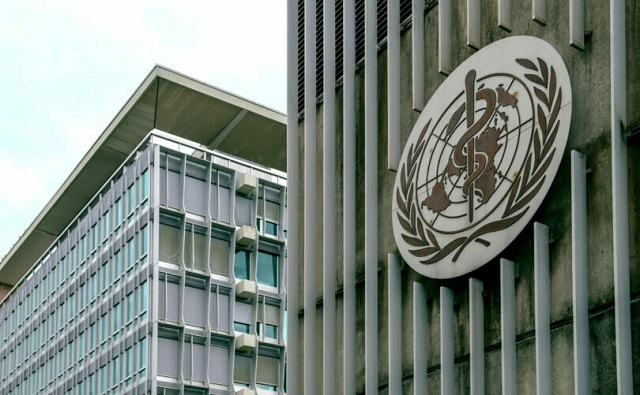Great Reset
Dr. Malone: ‘Disease X’ is manufactured by the WHO to drive fear and public compliance

Building of the World Health Organization in Geneva, Switzerland
From LifeSiteNews
Don’t be fooled by Disease ‘X’ or ‘Y’ or ‘Z.’ These aren’t real diseases. They are being weaponized to acceptance of the transfer of both funding and authority to an unelected globalist non-governmental organization – the WHO.
I have been working in the public health sector for over 30 years. This includes a fellowship at Harvard and numerous other courses on bioethics. In all that time, there has been one clear message: for the emotional and physical wellbeing of the public, the government and public health must not incite fear without cause, and that to do so is unethical and immoral, akin to yelling “fire” or “active shooter” in a crowded movie theater. That public trust requires transparency and truth telling on the part of public health officials and government.
The CDC codifies this basic premise in their public health risk communication statement:
Be first, be right, be credible. That’s the mantra for crisis communication. Health communicators, whenever a crisis occurs, always be prepared to provide information to help people make the best possible decisions for their health and well-being. [Emphasis added]
READ: WHO’s Dr. Tedros says new global pandemic is matter of ‘when’ not ‘if’ at 2024 Davos summit
In 2018, the World Health Organization came up with the idea of “Disease X,” which is a placeholder for a disease that could be a potential cause of a future major epidemic or a pandemic. The original idea being that planning for an (imaginary) “Disease X” would allow for scientists, public health officials, and physicians to design the best possible practices for a future epidemic or pandemic. They then formally added “Disease X” (an imaginary disease) to the top priority list of pathogens.
The idea behind Disease X was later weaponized to create a fog of fear in the public as well as governments. The weaponization started with COVID-19 communications. In a 2021 study, it was found that the “the only predictor of behavior change during COVID-19 was fear.” Despite their finding that such fear was related to a decrease in both emotional and physical wellbeing, the authors concluded that using fear to drive the public into compliance was the only path forward for public health. The authors write:
However, fear of COVID-19 was related to decreased physical and environmental wellbeing. Overall, these results suggest that ‘fear’ and anxiety at the current time have a functional role, and are related to increased compliance for improving public wellbeing.
‘Damn the torpedoes full steam ahead’
Without further questioning of the basic ethics behind using fear to drive compliance, this logic then became the consensus of public health officials and governments throughout the world. That being that the use of fear to get compliance for vaccines and vaccine mandates, vaccine passports, masking, lockdowns, social distancing, school closures, etc., was acceptable in the name of public health. That the decreased emotional and physical wellbeing of the general public by the promotion of fear tactics was an acceptable side effect.
Exit COVID-19… stage left. Enter ‘Disease X’… stage right
And just like that, “Disease X” has been substituted for COVID-19.
Without any qualms whatsoever, The World Health Organization (WHO) has gone from launching a global scientific process using Disease X as a model, to using “Disease X” as a propaganda driver to drive fear of an imaginary infectious disease. Then to use that fear to get public and governmental compliance for a new pandemic treaty, and more money for the WHO. Such weaponized fear (fearporn) also has been found to elicit more public compliance for public health measures, such as masking, social distancing, vaccines, and lockdowns.
The gradual shift was subtle. In April 2023, the WHO wrote:
Disease X represents the knowledge that a serious international epidemic could be caused by a pathogen currently unknown to cause human disease. The R&D Blueprint explicitly seeks to enable early cross-cutting R&D preparedness that is also relevant for an unknown ‘Disease X.’
In 2024, the WHO gave the general warning (without any data what-so-ever) that the imaginary Disease X could result in 20 times more fatalities than COVID-19.
Of course, there are some people who say this may create panic. It’s better to anticipate something that may happen because it has happened in our history many times, and prepare for it.
Bottom line is that Director-General Tedros now openly admits that the WHO is using fear to drive governments to open their pocket books and to drive compliance for the new pandemic treaty.
And the WHO’s fear mongering is working, the House recently introduced a new bill H.R.3832 – Disease X Act of 2023.
The bill reads:
This bill expands the priorities of the Biomedical Advanced Research and Development Authority (BARDA) to specifically include viral threats that have the potential to cause a pandemic.
In particular, the bill expands the scope of innovation grants and contracts that may be awarded by BARDA to specifically include those that support research and development of certain manufacturing technology for medical countermeasures against viruses, including respiratory viruses, with pandemic potential. It also expands BARDA’s authorized strategic initiatives to include advanced research, development, and procurement of countermeasures and products to address viruses with pandemic potential.
In order to understand the significance of this bill, it is important to understand what BARDA is:
(BARDA)’ is a U.S. Department of Health and Human Services (HHS) office responsible for the procurement and development of medical countermeasures, principally against bioterrorism, including chemical, biological, radiological and nuclear (CBRN) threats, as well as pandemic influenza and emerging diseases.
This bill is a sneaky backdoor to significantly expand the mission space of BARDA to include research into viruses. In the past, BARDA has been limited in their scope, so as to not compete with NIH. The expansion of yet another agency with very few limits on their scope is not in the public interest.
So, here is an easy ask. Contact your House representative and let them know how you feel about H.R.3832 – Disease X.
In the meantime, don’t be fooled by Disease “X” or “Y” or “Z.” These aren’t real diseases. They are made-up. They are being weaponized to gain compliance, drive fear, and to gain acceptance of the transfer of both funding and authority to an unelected globalist non-governmental organization – the WHO.
Yes, we have a problem with ongoing gain-of-function research and China is continuing on with its dangerous gain-of-function experiments. By all accounts, these are being conducted in poorly controlled laboratory environments. But such experiments aren’t limited to China; they are also happening in the USA. In 2023, Boston University School of Medicine scientists created a highly lethal SARS-CoV variant, which they then tested on mice.
Furthermore, the Biological Weapons Convention does not prohibit biological weapons, as an overlooked loophole allows for development, manufacture, and stockpiling of such for prophylactic, protective, or other peaceful purposes. The convention must be re-negotiated. The Biological Weapons Convention also does not adequately address gain-of-function research, which must to be banned worldwide.
These are concrete ongoing issues that the World Health Organization is not addressing. If the WHO’s motive is to stop future threat of infectious disease, why are they not working on these issues?
How far the WHO and public health has fallen…
Reprinted with permission from Robert Malone.
Censorship Industrial Complex
Canadian university censors free speech advocate who spoke out against Indigenous ‘mass grave’ hoax

From LifeSiteNews
Dr. Frances Widdowson was arrested and given a ticket at the University of Victoria campus after trying to engage in conversation about ‘the disputed claims of unmarked graves in Kamloops.’
A Canadian academic who spoke out against claims there are mass unmarked graves of kids on former Indigenous residential schools, and who was arrested on a university campus as a result for trespassing, is fighting back with the help of a top constitutional group.
Dr. Frances Widdowson was arrested and given a ticket on December 2, 2025, at the University of Victoria (UVic) campus after trying to engage in conversation about “the disputed claims of unmarked graves in Kamloops,” noted the Justice Centre for Constitutional Freedoms (JCCF) in a recent news release.
According to the JCCF, Widdowson was trying to initiate a “good faith” conversation with people on campus, along with the leader of OneBC provincial party, Dallas Brodi.
“My arrest at the University of Victoria is an indication of an institution that is completely unmoored from its academic purpose,” said Widdowson in a statement made available to LifeSiteNews.
She added that the “institution” has been “perpetuating the falsehood” of the remains of 215 children “being confirmed at Kamloops since 2021, and is intent on censoring any correction of this claim.”
“This should be of concern for everyone who believes that universities should be places of open inquiry and critical thinking, not propaganda and indoctrination,” she added.
UVic had the day before Widdowson’s arrest warned on its website that those in favor of free speech were “not permitted to attend UVic property for the purpose of speaking publicly.”
Despite the warning, Widdowson, when she came to campus, was met with some “100 aggressive protesters assembled where she intended to speak at Petch Fountain,” noted the JCCF.
The protesters consisted of self-identified Communists, along with Antifa-aligned people and Hamas supporters.
When Widdowson was confronted by university security, along with local police, she was served with a trespass notice.
“When she declined to leave, she was arrested, detained for about two hours, and charged under British Columbia’s Trespass Act—an offence punishable by fines up to $2,000 or up to six months’ imprisonment,” said the JCCF.
According to Constitutional lawyer Glenn Blackett, UVic actions are shameful, as it “receives hundreds of millions of taxpayer dollars annually while it facilitates the arrest of Canadians attempting to engage in free inquiry on campus.”
Widdowson’s legal team, with the help of the JCCF, will be defending her ticket to protect her “Charter-protected freedoms of expression and peaceful assembly.”
Widdowson served as a tenured professor at Mount Royal University in Calgary, Alberta, before she was fired over criticism of her views on identity politics and Indigenous policy, notes the JCCF. She was vindicated, however, as an arbitrator later found her termination was wrongful.
In 2021 and 2022, the mainstream media ran with inflammatory and dubious claims that hundreds of children were buried and disregarded by Catholic priests and nuns who ran some Canadian residential schools. The reality is, after four years, there have been no mass graves discovered at residential schools.
However, as the claims went unfounded, over 120 churches, most of them Catholic and many of them on Indigenous lands that serve the local population, have been burned to the ground, vandalized, or defiled in Canada since the spring of 2021.
Last year, retired Manitoba judge Brian Giesbrecht said Canadians are being “deliberately deceived by their own government” after blasting the former Trudeau government for “actively pursuing” a policy that blames the Catholic Church for the unfounded “deaths and secret burials” of Indigenous children.
As reported by LifeSiteNews, new private members’ Bill C-254, “An Act To Amend The Criminal Code” introduced by New Democrat MP Leah Gazan, looks to give jail time to people who engage in so-called “Denialism.” The bill would look to jail those who question the media and government narrative surrounding Canada’s “Indian Residential School system” that there are mass graves despite no evidence to support this claim.
Digital ID
Canadian government launches trial version of digital ID for certain licenses, permits

From LifeSiteNews
The Employment and Social Development Canada (ESDC) department has officially confirmed it is developing a digital ID for certain licenses and permits.
The Employment and Social Development Canada (ESDC) department has officially confirmed it is developing a digital ID for certain licenses and permits, called “GC Issue and Verify,” which has already been listed on the Google Play store, as a trial-only app for certain users.
The digital ID claims the government can replace and be full “digital versions” of the “physical credentials they already provide today, like work permits and boating licenses.”
“Instead of only having physical credentials in their wallets, people will also be able to securely store their digital credentials on their mobile devices,” says the government.
According to ESDC officials, the digital IDs can be shared online or in-person “when needed, making it easy for departments, organizations, and businesses to validate their information.”
The government argued that since many Canadians already use “digital credentials without realizing it,” such as a digital ticket “stored on our mobile device instead of using a printed ticket,” this would be the same for IDs such as licenses.
ESDC said that “digital options” will be voluntary and that people can still use “traditional physical methods of verification,” instead.
READ: Canada releases new digital ID app for personal documents despite privacy concerns
The reality is that digital IDs and similar systems have long been pushed by globalist groups like the World Economic Forum, an organization with which Canadian Prime Minister Mark Carney has extensive ties, under the guise of ease of access and security.
Also, Canadians do not want digital IDs, as noted by Canada’s Privy Council research from 2023, which said there is strong public resistance to the use of digital IDs to access government services.
GC Issue and Verify is one of two digital ID projects on the go. As reported by LifeSiteNews, the Liberal government under Carney recently quietly released a new type of digital ID app on Google’s Play Store called GC Wallet.
Both GC Wallet and GC Issue and Verify are now being tested with federal partners, those being Transport Canada and Immigration, Refugees and Citizenship Canada.
During COVID, the Canadian federal government released a digital-type app called ArriveCAN app for travel that was a form of digital ID. The app was riddled with technical glitches along with privacy concerns from users.
As reported by LifeSiteNews, the Canadian government hired outside consultants tasked with looking into whether or not officials should proceed with creating a digital ID system for all citizens and residents.
Opp0sition MP Leslyn Lewis, recently warned Canadians to be “on guard” against a push by the ruling Liberal Party to bring forth digital IDs, saying they should be voluntary.
-

 armed forces2 days ago
armed forces2 days agoOttawa’s Newly Released Defence Plan Crosses a Dangerous Line
-

 espionage2 days ago
espionage2 days agoCarney Floor Crossing Raises Counterintelligence Questions aimed at China, Former Senior Mountie Argues
-

 Health2 days ago
Health2 days agoAll 12 Vaccinated vs. Unvaccinated Studies Found the Same Thing: Unvaccinated Children Are Far Healthier
-

 Energy2 days ago
Energy2 days ago75 per cent of Canadians support the construction of new pipelines to the East Coast and British Columbia
-

 Opinion2 days ago
Opinion2 days agoPope Leo XIV’s Christmas night homily
-

 armed forces2 days ago
armed forces2 days agoRemembering Afghanistan and the sacrifices of our military families
-

 Fraser Institute21 hours ago
Fraser Institute21 hours agoCarney government sowing seeds for corruption in Ottawa
-

 Daily Caller21 hours ago
Daily Caller21 hours agoWhile Western Nations Cling to Energy Transition, Pragmatic Nations Produce Energy and Wealth





